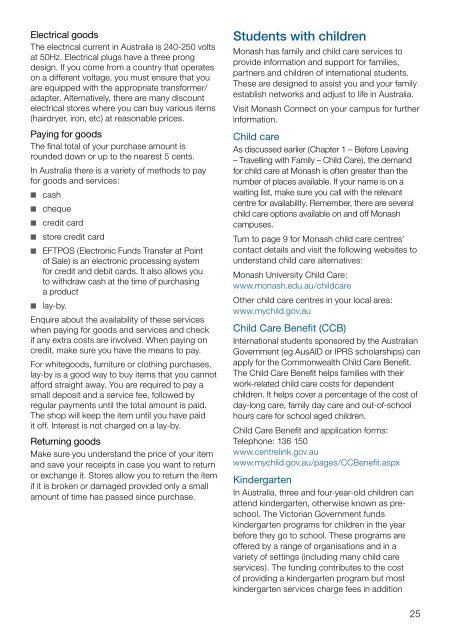Destination
Create successful ePaper yourself
Turn your PDF publications into a flip-book with our unique Google optimized e-Paper software.
Electrical goods<br />
The electrical current in Australia is 240-250 volts<br />
at 50Hz. Electrical plugs have a three prong<br />
design. If you come from a country that operates<br />
on a different voltage, you must ensure that you<br />
are equipped with the appropriate transformer/<br />
adapter. Alternatively, there are many discount<br />
electrical stores where you can buy various items<br />
(hairdryer, iron, etc) at reasonable prices.<br />
Paying for goods<br />
The final total of your purchase amount is<br />
rounded down or up to the nearest 5 cents.<br />
In Australia there is a variety of methods to pay<br />
for goods and services:<br />
n cash<br />
n cheque<br />
n credit card<br />
n store credit card<br />
n EFTPOS (Electronic Funds Transfer at Point<br />
of Sale) is an electronic processing system<br />
for credit and debit cards. It also allows you<br />
to withdraw cash at the time of purchasing<br />
a product<br />
n lay-by.<br />
Enquire about the availability of these services<br />
when paying for goods and services and check<br />
if any extra costs are involved. When paying on<br />
credit, make sure you have the means to pay.<br />
For whitegoods, furniture or clothing purchases,<br />
lay-by is a good way to buy items that you cannot<br />
afford straight away. You are required to pay a<br />
small deposit and a service fee, followed by<br />
regular payments until the total amount is paid.<br />
The shop will keep the item until you have paid<br />
it off. Interest is not charged on a lay-by.<br />
Returning goods<br />
Make sure you understand the price of your item<br />
and save your receipts in case you want to return<br />
or exchange it. Stores allow you to return the item<br />
if it is broken or damaged provided only a small<br />
amount of time has passed since purchase.<br />
Students with children<br />
Monash has family and child care services to<br />
provide information and support for families,<br />
partners and children of international students.<br />
These are designed to assist you and your family<br />
establish networks and adjust to life in Australia.<br />
Visit Monash Connect on your campus for further<br />
information.<br />
Child care<br />
As discussed earlier (Chapter 1 – Before Leaving<br />
– Travelling with Family – Child Care), the demand<br />
for child care at Monash is often greater than the<br />
number of places available. If your name is on a<br />
waiting list, make sure you call with the relevant<br />
centre for availability. Remember, there are several<br />
child care options available on and off Monash<br />
campuses.<br />
Turn to page 9 for Monash child care centres’<br />
contact details and visit the following websites to<br />
understand child care alternatives:<br />
Monash University Child Care:<br />
www.monash.edu.au/childcare<br />
Other child care centres in your local area:<br />
www.mychild.gov.au<br />
Child Care Benefit (CCB)<br />
International students sponsored by the Australian<br />
Government (eg AusAID or IPRS scholarships) can<br />
apply for the Commonwealth Child Care Benefit.<br />
The Child Care Benefit helps families with their<br />
work-related child care costs for dependent<br />
children. It helps cover a percentage of the cost of<br />
day-long care, family day care and out-of-school<br />
hours care for school aged children.<br />
Child Care Benefit and application forms:<br />
Telephone: 136 150<br />
www.centrelink.gov.au<br />
www.mychild.gov.au/pages/CCBenefit.aspx<br />
Kindergarten<br />
In Australia, three and four-year-old children can<br />
attend kindergarten, otherwise known as preschool.<br />
The Victorian Government funds<br />
kindergarten programs for children in the year<br />
before they go to school. These programs are<br />
offered by a range of organisations and in a<br />
variety of settings (including many child care<br />
services). The funding contributes to the cost<br />
of providing a kindergarten program but most<br />
kindergarten services charge fees in addition<br />
25


